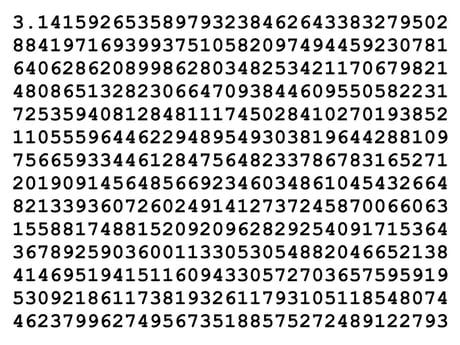The Incredible World of Pi: Why 3.14 is My Favorite Number Ever!
3.14 is My Favorite Number Ever!
Saumya Wagh
3/14/20252 min read


This month is the Pi (π) month since it has the Pi Day (March 14th, get it? 3/14). I want to talk about the most fascinating number that exists: Pi (π)! You might think, "Really? A number is fascinating?" But trust me - this isn't just any number!
What Makes Pi So Special?
Pi is that magical 3.14... number that represents the ratio between a circle's circumference and its diameter. What's mind-blowing is that no matter how big or small your circle is - from a tiny bead on my friendship bracelet to literally Saturn's rings - this ratio always stays the same!
The craziest part? Pi never ends and never repeats any pattern. Scientists have calculated billions of digits, and they still haven't found any repeating sequence. How cool is that? It's like the universe created an infinite secret code!
Fun fact: If you could write out just the first trillion digits of pi, your number would stretch from Earth to the moon and back... 30 times!
Pi in the Natural World (It's Not Just a Math Thing!)
Last weekend, I was walking in the park when I noticed something amazing about the river. The way it curves and bends. That's actually related to pi! Rivers naturally form meanders (those snake-like curves), and scientists have found that the ratio of the river's actual length along these curves compared to the straight-line distance is often close to pi. How cool is that? Nature basically "knows" pi!
When I look at flowers, I see pi there too! Many flowers have petals arranged in numbers that are related to the Fibonacci sequence (like 3, 5, 8, 13 petals), and the ratio between consecutive Fibonacci numbers gets closer and closer to something called the Golden Ratio - which is connected to pi! Next time you see a sunflower, count the spiral patterns of seeds - they're following mathematical rules!
Pi in STEM
In physics, pi helps us calculate pendulum periods and wave frequencies. Without pi, we couldn't model sound waves, light waves, or even understand how energy moves through space!
In engineering, pi is essential for designing anything circular – from gears and wheels to pipes and tunnels. Aerospace engineers use pi when calculating orbital mechanics for satellites and spacecraft trajectories.
Physicists encounter pi in wave equations, probability distributions, and quantum mechanics. The famous Heisenberg Uncertainty Principle contains pi in its formula, highlighting its role in defining the fundamental limits of precision in our universe.
In technology, pi helps power the algorithms behind digital image processing, music compression, and even artificial intelligence. Thank pi for all that.
Beyond the Classroom
Pi isn't just for science fans like me (though we claim it proudly!). It's essential for engineering bridges, designing headphones, developing medical equipment, and even creating the special effects in my favorite movies!
The most mind-blowing fact I learned this year: NASA only uses 15 decimal places of pi for their spacecraft calculations. That's precise enough to calculate the circumference of the entire observable universe with an error smaller than the width of a single atom!
Whether you're into coding, engineering, or just appreciate beautiful patterns in nature, pi deserves way more recognition than just being "that circle number." It's basically the universe's secret signature written into everything around us!
So next Pi Day, while you're enjoying a slice of actual pie, remember you're celebrating one of the coolest mathematical constants ever discovered!
